MENU
MENU
Tea made from Dutch soil
There is a company that cultivates, produces and sells tea in Zundert located in the Southern Netherlands near the border of Belgium. The name of the company is Local Tea. Local Tea cultivates about 1.7 million tea plants in greenhouses and the total cultivation area is around 1.7 hectares.

Greenhouse made with glasses in Local Tea
(March 2024)
The Beginning of Local Tea
Mr. Johan Jansen who is the son of tomato farmer in Zundert went to China and encountered tea in 2008. Then, he conceived of planting tea in Holland.
With support from investors, Johan starts a tea seedling cultivation business in Holland. He imported tea seedlings from tea-producing areas around the world, but most of them died because they couldn’t withstand the cold and dry weather in Holland. However, he continued breeding for over 8 years and finally created a variety that could withstand the colder climate. Then, he started a business that cultivated nursery stocks of a tea and other plants, and sold them. When selling a nursery stock of tea plants, the way of growing tea plants is also explained to consumers.
The business got on the right track. He sold the business to investors so that he could start a new business.

Tea plants are ordered from the tea production areas around the world (March 2024)
The general manager who moved from the tea department of a major company
Mr. Wouter Eckelmans, manages the whole business as a general manager at Local Tea. Wouter has experience working as a marketing director for tea departments in major companies. In 2021, he was scouted by the investors of Local Tea to work as a general manager.
When he was working at the major companies, he visited the tea gardens in Sri Lanka for his work.
Although the working conditions of workers in tea gardens have improved since the colonial era in Sri Lanka and India, the working conditions are still severe.
Wouter believes that companies should not only seek profits, but should also consider nature and the working environment, produce high-quality products, and explain this to consumers so that consumers can understand the production process and select products before purchasing products.
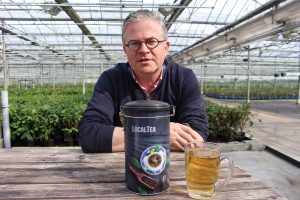
Mr. Wouter Eckelmans,
General Manager of Local Tea (March 2024)
Tea cultivation like vegetable cultivation
When you see the tea plants cultivated in pots in the greenhouse of Local Tea, you will have the impression of vegetable cultivation such as tomatoes.
The walls and ceilings of the greenhouse are made of glass. The greenhouse is heated by only sunlight, not fuel or electricity. When I visited Local Tea in the middle of March in 2024, the temperature was about 26 degrees Celsius in the greenhouse.
The temperature is controlled by a computer. When the temperature is above the set temperature, a part of the ceiling automatically opens and adjusts the temperature in the greenhouse.

Tea plants in pots in the greenhouse (March 2024)
Pests are prevalent even in the greenhouse and Local Tea uses beneficial insects to control pests. Additionally, Local Tea doesn’t use any agricultural chemicals or chemical fertilizers.

Beneficial insects in the greenhouses (March 2024)
Tea plants in pots
The tea plants in pots are sold not only in the Netherlands but also in countries such as France, Switzerland, Northern Ireland, Poland, and Serbia, for both garden and ornamental plants.

Tea plants in pots (March 2024)
Tea leaves for drinking purposes are mainly processed into tea bags and sold to major supermarkets and restaurants in the Netherlands.
The material of tea bags is polylactic acid (PLA) made from organic, recyclable resources such as derivatives of corn, which do not use fossil fuels.

Local Tea’s tea bags (March 2024)
Plucking of tea leaves is carried out a total of 5 to 6 times between the end of March and September. After plucking new buds of tea leaves, they wait until new buds come out, then the next new buds are plucked. This process is repeated around 5 times. The tea leaves are plucked using a movable machine that can be operated by one person while standing. Wouter said that so far, there have been no complaints of lower back pain from staff due to using the machine.

New shoots (March 2024)
Because it is warm in the greenhouse, the size of tea leaves is larger than the average tea leaves in Japan. When I measured the length of a large leaf, it was about 10 cm.
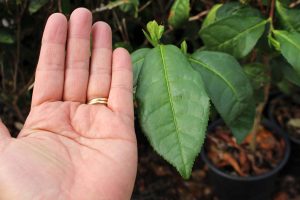
A large size of tea leaf (March 2024)
The importance of local production for local consumption
Local Tea believes that by drinking Dutch tea in the Netherlands, up to 96% of CO2, 99% of energy and 99% of water can be saved.
When selling the teas of Local Tea in the Netherlands, compared to foreign tea, the supply chain from the place of purchasing raw material to the consumers is shorter, and therefore fuel and CO2 emissions required for transportation become less. Additionally, Local Tea uses only sunlight for heating the greenhouse without fuel and electricity and reuses the sprinkled water through the closed system in the greenhouse.
Local Tea says that drinking this locally produced tea has a positive impact on both consumers and the environment. As a result, it contributes to maintaining a sustainable society.
The tea produced by Local Tea costs about twice as much as Indian or Sri Lankan tea bags sold in supermarkets in the Netherlands. Thus, it can be said that the main consumers are highly aware of the environment and have disposable income.
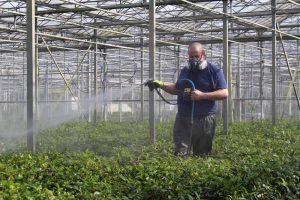
A member of staff is sprinkling water in the greenhouse
(March 2024)
Learned processing tea techniques by self-study
Local Tea makes green tea, black tea, oolong tea, yellow tea and flavored tea.
Before, Local Tea processed tea using a big iron plate by hand. Now they process tea using machines.
Mr. Frank Ver Boven, in charge of processing tea, cultivated cucumbers in his previous job. He didn’t have any knowledge or experience of processing tea. When Frank started working at Local Tea, he read books on processing tea and learned it through trial and error. The tea processing machines that Local Tea uses are a parching machine, a rolling machine and a drier.
Local Tea’s processing method for green tea is similar to that of Chinese and Korean pan-fired green tea. First, plucked tea leaves are withered, and heated in a parching machine. Then the leaves are rolled in the rolling machine and dried in the drier. The brewed color of the green tea is light golden brown. The tea doesn’t have much of an aroma, and it has a less bitter and astringent taste. The flavor is similar to semi-fermented tea.
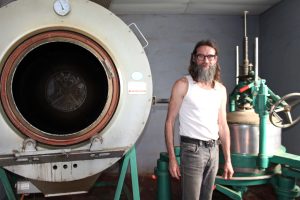
Mr. Frank Ver Boven and tea processing machines (March 2024)
Tea grown in Belgian soil
Local Tea is selling the tea that contracted tea farmers cultivate in a neighboring country of Belgium. About 60,000 tea plants are cultivated there.
Local Tea produces varieties of flavored tea using only natural ingredients such as citrus, chamomile, ginger, cinnamon, globe, raspberry, and strawberry. These teas are sold on their website.
The online shop also sells tea with a portion of the purchase price being donated to organizations for people with physical disabilities.
Local Tea is planning to produce Japanese-style Sencha and Matcha too.
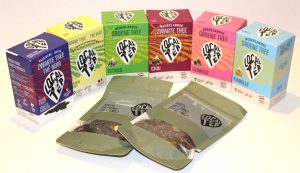
The boxes in dark blue and yellow are the tea cultivated in Belgium (March 2024)
There are many gardening plants other than tea plants in the glass and vinyl greenhouses, and outside.
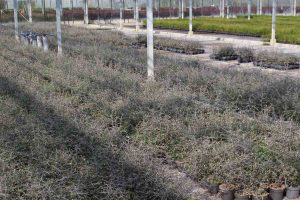
Corokia in a pot (March 2024)
Local Tea
Website: https://www.localtea.com/
Webshop: https://www.webshop.localtea.com/
Address: Gaardsebaan 11c, 4881 ME ZUNDERT, The Nederlands
How to get to Local Tea:
Take a bus of 115 from Breda Central Station to Zundert W. Passtoorsstraat Bus Stop. It takes about 30 minutes from Breda Bus Stop to Zundert W. Passtoorsstraat Bus Stop by bus. Then, walk to Local Tea from the Zundert W. Passtoorsstraat Bus Stop for about 30 minutes.
Opening hours:
Close:

Photo left: Breda railway St.
Photo right: Zundert W. Passtoorsstraat Bus Stop
*When visiting the shops and facilities introduced in this article, please check the business hours on their website, etc. before visiting.
*The information provided on this site may be updated. If you find any information in this article that is incorrect, new, or incomplete, please contact CHAMART.
Vincent van Gogh House Museum (Vincent van GoghHuis)
The Vincent van Gogh House Museum (Vincent van GoghHuis) is located in Zundert.
Zundert, where the local tea is located, is the town where artist Vincent van Gogh was born. The house where Gogh grew up doesn’t remain, but the museum was built on the site of the house.
You can tour the museum while listening to an audio guide and learn about his personal history. Audio guides are available in multiple languages, including English and Japanese.
The teas of Local Tea are sold at the museum shop.
https://www.vangogh-drenthe.nl/
